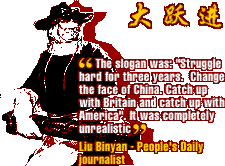|
|
 |
  |
|
|
In an attempt to break with the Russian model of Communism and to catch up with more advanced nations, Mao proposed that China should make a "great leap forward" into modernisation. He began a militant Five Year Plan to promote technology and agricultural self-sufficiency. Overnight, fertile rice fields were ploughed over, and factory construction work began. Labour-intensive methods were introduced and farming collectivised on a massive scale. The campaign created about 23,500 communes, each controlling its own means of production. But former farmers had no idea how to actually use the new factories and what was once fertile crop land went to waste on a disastrous scale. The Great Leap Forward was held responsible for famine in 1960 and 1961. Twenty million people starved, and Mao Zedong withdrew temporarily from public view. |